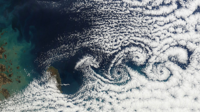Chaosrand
Physik
Grundidee
Am Ufer von Flüssen kann man oft erkennen, dass in der Flussmitte das Wasser immer glatt geradeaus fließt. Am Ufer, vor allem wenn es unregelmäßig geformt ist, fließt das Wasser hingegen oft chaotisch in vollkommener Ordnungslosigkeit. Dazwischen, im Grenzbereich liegt der Chaosrand, die Grenze zwischen Chaos und Ordnung. An solchen Chaosrändern sollen sich manchen Autoren[1] zufolge besonders komplexe, lebende und hochorganisierte Systeme ausbilden. Siehe auch Evolution ↗
Fußnoten
- [1] Roger Lewin: Die Komplexitätstheorie. Knaur Verlag. 1996. ISBN: 3-42-7190-X. Hier das Kapitel drei: Am Rand des Chaos. Seite 63 ff. (englische Buchtitel: Complexity. Life at the Edge of Chaos.)
- [2] Ranjit Kumar Upadhyay (2009). "Dynamics of an ecological model living on the edge of chaos". Applied Mathematics and Computation. 210 (2): 455–464. doi:10.1016/j.amc.2009.01.006.
- [3] Lawler, E.; Thye, S.; Yoon, J. (2015). Order on the Edge of Chaos Social Psychology and the Problem of Social Order. Cambridge University Press. ISBN 9781107433977.
- [4] H. Packard, Norman (1988). "Adaptation Toward the Edge of Chaos". University of Illinois at Urbana-Champaign, Center for Complex Systems Research. Retrieved 12 November 2020.
- [5] Mitchell, Melanie; T. Hraber, Peter; P. Crutchfleld, James (1993). "Revisiting the Edge of Chaos: Evolving Cellular Automata to Perform Computations"
